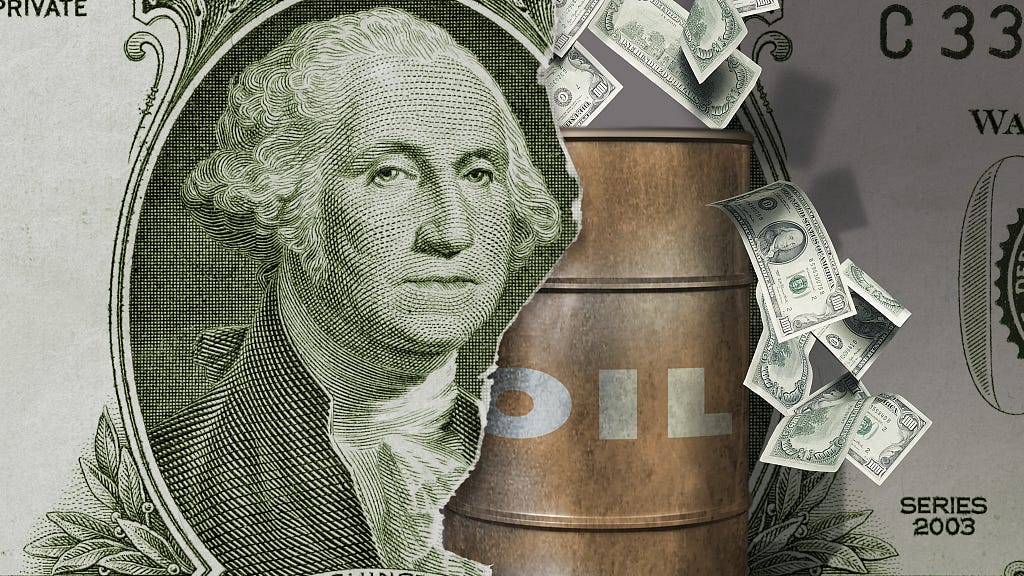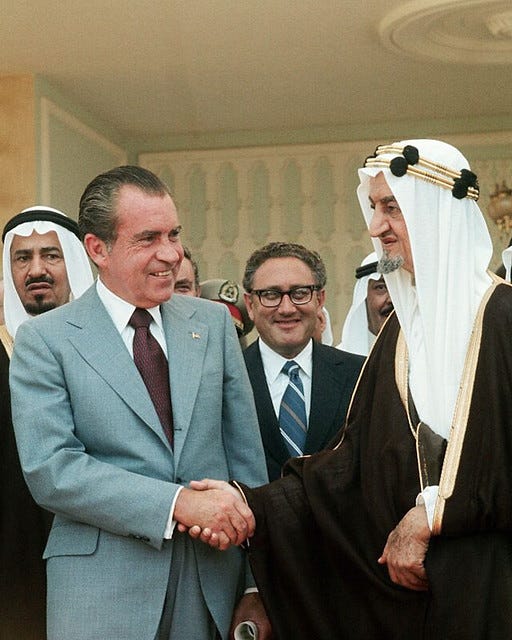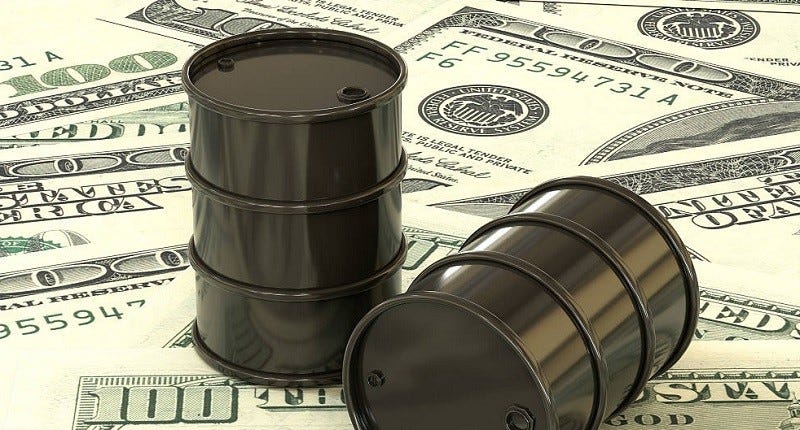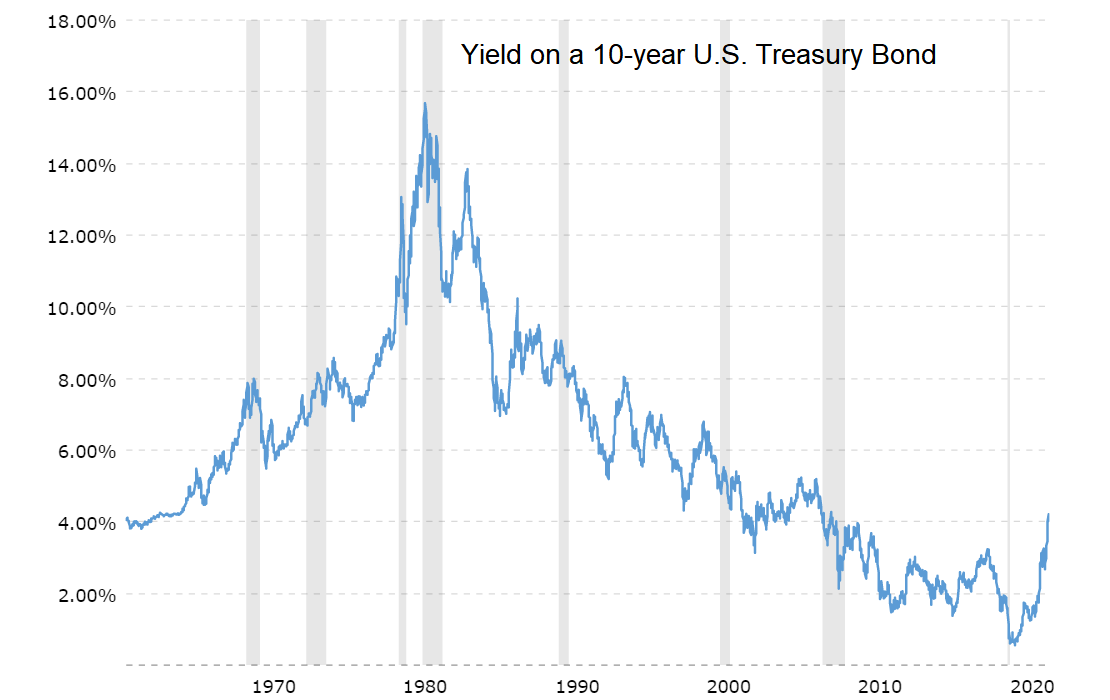Empire of Dollars 5

How the United States of America maintains control of the global monetary system - part 5: The petrodollar
The petrodollar system is the practice of trading oil for U.S. dollars, and U.S. dollars only.[1] The petrodollar system was the result of a bilateral trade agreement the United States had with the Kingdom of Saudi Arabia, an agreement that would be extended to the whole of OPEC by the mid-70s.[2] The petrodollar system brings numerous exclusive benefits to the United States such consolidating demand for the dollar in the global economy, allowing the U.S. to purchase oil in its own currency and giving them the upper hand in world trade. It has also led to a greatly expanded market for U.S. Treasury bonds.
The petrodollar has a central role in the dollar system: as oil is the most sought-after commodity in the world, being priced and traded solely in dollars contributes immensely to the dollar’s central position in the global monetary system.[3] In fact, the petrodollar has had a considerable impact on shaping U.S. foreign policy, global trade and geopolitics for the last 50 years. Some analysts have called this system the most brilliant economic and geopolitical strategy devised in recent history. The petrodollar is arguably one of the most important arms of American power today and maintaining it is essential to America’s ongoing hegemonic position in the world.
The removal of the international gold standard in 1971 caused a decline in the demand for the U.S. dollar worldwide. Maintaining this demand was vital if the United States were to continue heavy spending both at home and abroad, not doing so would have had serious consequences for the American empire going forward. The 1973 oil embargo by OPEC caused tremendous problems for the United States: OPEC cut production and reduced the output of crude oil sending prices sky rocketing, increasing to $33 a barrel in America at the peak of the crisis.[4] This resulted in rationing and queueing for gasoline, civil unrest and even violence across the country. For a more detailed exploration on the background and historical context behind the petrodollar please read my article here.
In 1973, President Richard Nixon, the Secretary of State Henry Kissinger and U.S. Treasury secretary William Simon began negotiating with King Faisal of Saudi Arabia to accept only U.S. dollars as payment for oil as well as their personal assurances that there would never be another oil embargo again. In return, the U.S. would provide military support for Saudi oil fields and for the house of Saud generally (effectively guaranteeing their rule over the kingdom). Washington also agreed to sell weapons and other military grade hardware to the Saudis.[5]

The petrodollar arrangement is highly significant because it meant that there was now a legitimate outlet for the huge volume of dollars that had built-up abroad during the Bretton Woods era as, from this point onwards, countries would need U.S. dollars to fund all future oil purchases. By 1975, every OPEC member agreed to sell their oil exclusively in dollars.[6] The deal also stated that if other oil producing countries threatened an embargo, Saudi Arabia would fill the shortage by increasing oil production or by drawing from its huge oil reserves. Under the agreement, oil prices were allowed to fluctuate but only to levels deemed suitable by Washington and in the best interests of the United States and its allies.
By tying the dollar to oil it created an immediate artificial demand for U.S. dollars around the globe. For oil-importing nations, to fund oil purchases they first need to acquire dollars. The Spanish and French cannot use euros, the Indians cannot use rupees and the Swiss cannot use francs; every country needs U.S. dollars to purchase oil. As global oil demand increases so does the demand for U.S. dollars. Increasing the demand for the dollar raises its value, keeping it strong. Oil is always in demand and thus so are dollars, the petrodollar system ensures that demand for the U.S. dollar is ever-present in the global economic system. For oil-importing nations the reality is that you must first purchase dollars to fund any oil transactions; no dollars no oil, it really is that simple! Oil is energy, you need energy to build industries, power economies and grow entire countries, and you cannot do this without oil. From in its inception, the nature of the petrodollar agreement had demand for the U.S. dollar built into the system, the same system we have today.

Under the terms of this agreement the U.S. can purchase oil in its own currency. All they have to do is summon the Bureau of Engraving and Printing to print the required amount of bills, take these to an OPEC member state and the deal is done. No other nation can do this because oil is traded in dollars only. Instead, other countries must provide real goods and services (or enter the foreign exchange markets) to acquire dollars before being able to purchase oil. The petrodollar arrangement effectively means that the U.S. was now not forced to consume less or produce more in order to meet its future energy requirements.
The petrodollar system allows the United States to assume the upper hand in world trade. Simply put, the act of moving the dollar off gold and tying it to foreign oil forced every oil importing nation in the world to create and maintain a consistent supply of dollars and to get dollars they would have to send real physical goods to America. Countries had to maintain good relations with Washington as they needed ample supplies of dollars to maintain healthy foreign currency reserves, for trade and for future oil purchases too.[7] The result of all this is that the petrodollar system encouraged cheap exports to the United States as oil-importing nations restructured their trade policies in line with Washington’s requirements to bring in more dollars. U.S. dollars went out and everything America needed came in and came in on Washington’s terms no less and the U.S. got very, very rich as a result. Whether that is copper from Chile, rubber from Malaysia or coffee from Guatemala the United States will always have the upper hand in trade negotiations.
Petrodollar Recycling
As l have alluded to already, one of the most important parts of the petrodollar arrangement is that in essence the U.S. receives a double loan out of every single barrel of oil that is sold worldwide, as every barrel of oil that is sold on the world market increases the demand for U.S. dollars and it also increases the demand for U.S. Treasuries as well. That means that even if, say, Spain or Japan wants to purchase oil the U.S. benefits from the transaction twofold because the terms of the petrodollar arrangement mean that 1) they must first acquire dollars to facilitate the transaction and 2) OPEC pledges to use a portion of the profits from the sale to purchases U.S. Treasuries. In essence, the United States receives a nominal sum of dollars on every oil transaction that takes place in the form of these Treasury bond purchases, thus creating a parallel revenue stream that runs alongside oil transactions and one that continues to this day.[8] The act of using a portion of the profits from oil sales to buy U.S. debt would eventually be termed as “petrodollar recycling”. Petrodollar recycling is a form of debt financing.[9] Debt financing is when a government monetises its debt, often abroad, in the form of government-backed debt securities with annual interest paid to whomever holds the debt. The point is that the U.S. can issue dollar-denominated debts at very low rates of interest, because countries need to have an ample supply of dollars on hand to facilitate trade in oil and other commodities means that demand is permanently high. Every oil purchase increases the demand for U.S. dollars before the transaction and the demand for U.S. debt instruments after the transaction. Under this system, Washington was now able to monetise its debts with the expanded Treasury bond market, as countries looked to secure dollar holdings to fund future oil purchases by exchanging dollars for U.S. debt securities.
In The Hidden Hand of American Hegemony, political economist David E. Spiro argues that excess profits from oil sales were “recycled” into U.S. Treasuries to subsidise the “debt-happy policies of the U.S. government as well as the debt-happy consumption of its citizenry”. When countries buy U.S. Treasury bonds, they are subsidising American debt and consumption by allowing the U.S. to spend more money than it earns through trade in goods and services. Over time, petrodollar recycling pushed down interest rates for Washington (see below).

Petrodollar recycling has allowed the U.S. to issue debt very cheaply to American citizens and corporations as the Federal government need not rely on high interest rates at home as a means of revenue because dollars continue to pour in from abroad. With both the petrodollar system and the Treasury market working in tandem together, banks can issue credit with low rates of interest domestically just as the federal government can issue government-backed securities to foreign suitors at low rates of interest to be paid by the U.S. to any nation that holds these Treasury notes. This allows the United States to run up huge deficits to pay for all its needs by borrowing indefinitely against the purchase of U.S. debt instruments by other nations who need to maintain a steady and consistent supply of dollars under this system. Declassified documents later revealed that the U.S. government confidentially enabled the Saudis to purchase Treasuries “outside regular auctions and at preferential rates.” The exact figures are highly confidential (as you might expect) but it has been estimated that trillions of dollars have been invested in U.S. debt since the inception of the petrodollar system.[10]
Lastly, now that oil was tied to the dollar the U.S. would be protected because in the event of an increase in the global price of oil there would be a corresponding increase in the demand for dollars along with it and this is exactly what happened during the second oil crisis in the late 70s: when the price of oil increased in the wake of the Iranian Revolution so did the demand for dollars. The U.S. has leverage at both ends of the market, allowing Washington to create conditions favourable to its own interests. A prime example of this was in the mid-80s when the Reagan administration along with OPEC, abolished price controls and removed production limits on oil: the price of oil was allowed to float and the global market was suddenly flooded with excess crude oil sending prices plummeting. The goal of this was to severely damage the USSR’s economy (oil was one of the Soviet Union’s main revenue streams). The resulting collapse in oil prices also contributed greatly to the Latin American debt crisis as well; countries such as Venezuela, Mexico, and Brazil relied heavily on oil revenue and when prices collapsed, they faced terrible economic consequences.[11] Another point that cannot be ignored is that all this power and leverage has allowed the United States to accumulate large stockpiles of oil reserves that protects the U.S. in the event of a global shortage.
The petrodollar agreement arrived at a crucial point in history, ensuring that the U.S. would have continued access to cheap oil and providing an essential anchor to the floating dollar, as well as laying the foundations for a greatly expanded market for U.S. Treasuries that allows the Washington to borrow indefinitely against the investment from creditor nations into U.S. debt. In retrospect, it is quite some achievement that the U.S. was able to have the world’s most precious and sought after commodity valued, priced and traded exclusively in dollars. Under the petrodollar arrangement the domain of United States is without borders and limits. Having the world’s most sought-after commodity priced and traded exclusively in dollars allows Washington to dictate large segments of world trade and global affairs. The petrodollar system consolidated the dollar’s position as the world reserve currency that has, in turn, contributed tremendously to the United States’ uncontested, unrivalled status as the global superpower in the world today.
Notes
[1] Clark, W. (2005) Petrodollar Warfare: Oil, Iraq and the Future of the Dollar. New Society Publishers. p.30
[2] Clark, W. (2005) Petrodollar Warfare: Oil, Iraq and the Future of the Dollar. New Society Publishers. p.33
[3] FollowtheMoney.com (2020) Preparing For The Collapse Of The Petrodollar System. Available at: https://followthemoney.com/preparing-for-the-collapse-of-the-petrodollar-system-part-1/.
[4] Office of Energy Efficiency and Renewal Energy Timeline: A Brief History of Oil Prices and Vehicle Technology at : https://www.energy.gov/eere/timeline-brief-history-oil-prices-and-vehicle-technologies
[5] Perkins, J. (2018) The New Confessions of an Economic Hit Man. EBURY PRESS. p.95- 98
[6] australianvoice (2015) How Does the US Empire Control the World? Petrodollars Rule, Ok! (Part 1). Available at: https://australianvoice.livejournal.com/12523.html.
[7] Clark, W. (2005) Petrodollar Warfare: Oil, Iraq and the Future of the Dollar. New Society Publishers. p.32
[8] Clark, W. (2005) Petrodollar Warfare: Oil, Iraq and the Future of the Dollar. New Society Publishers. p.21
[9] Spiro, D. (1999) The Hidden Hand of American Hegemony: Petrodollar Recycling and International Markets (Cornell Studies in Political Economy). 1st edn. Cornell University Press.
[10] Spiro, D. (1999) The Hidden Hand of American Hegemony: Petrodollar Recycling and International Markets (Cornell Studies in Political Economy). 1st edn. Cornell University Press.
[11] Harvey, B. D. (2022). A Brief History of Neoliberalism by Harvey, David [Oxford University Press, USA,2007] [Paperback] (1st (First) edition). Oxford University Press, USA.